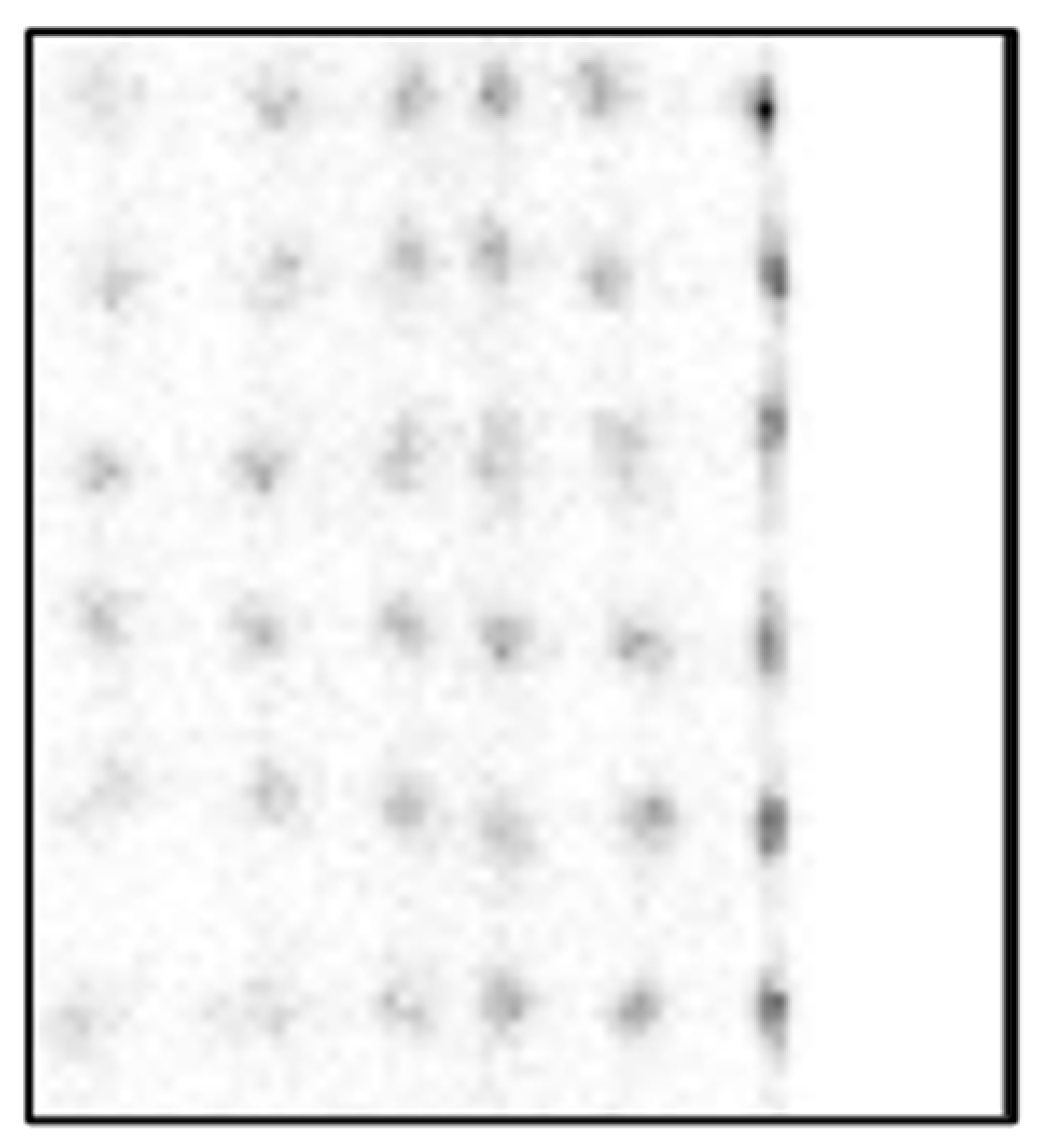Improved Edge Pixel Resolution in Modular PET Detectors with Partly Segmented Light Guides
Abstract
1. Introduction
2. Materials and Methods
2.1. Sensor Modules
2.2. Partly Segmented Light Guide (PSLG) Design
2.3. CoG and TCoG Coordinate Reconstruction Methods
2.4. Evaluation Methods
3. Results
4. Discussion
5. Conclusions
Author Contributions
Funding
Institutional Review Board Statement
Informed Consent Statement
Data Availability Statement
Acknowledgments
Conflicts of Interest
Abbreviations
| PET | Positron Emission Tomography |
| LYSO | Lutetium Yttrium Orthosilicate |
| SiPM | Silicon PhotoMultiplier |
| TOF | Time-of-Flight |
| CoG | Center of Gravity |
| TCoG | Truncated Center of Gravity |
| PSLG | Partly Segmented Light Guide |
| LD | Low Dose |
References
- Roncali, E.; Cherry, S.R. Application of silicon photomultipliers to positron emission tomography. Ann. Biomed. Eng. 2011, 39, 1358–1377. [Google Scholar] [CrossRef] [PubMed]
- Gundacker, S.; Heering, A. The Silicon Photomultiplier: Fundamentals and applications of a modern solid-state photon detector. Phys. Med. Biol. 2020, 65, 17TR01. [Google Scholar] [CrossRef] [PubMed]
- Lecoq, P.; Gundacker, S. SIPM applications in positron emission tomography: Toward ultimate pet time-of-flight resolution. EPJ Plus 2021, 136, 292. [Google Scholar] [CrossRef]
- Cherry, S.R.; Jones, T.; Karp, J.S.; Qi, J.; Moses, W.W.; Badawi, R.D. Total-body pet: Maximizing sensitivity to create new opportunities for clinical research and patient care. Eur. J. Nucl. Med. Mol. Imaging 2017, 59, 3–12. [Google Scholar] [CrossRef]
- Badawi, R.D.; Shi, H.; Hu, P.; Chen, S.; Xu, T.; Price, P.M.; Ding, Y.; Spencer, B.A.; Nardo, L.; Liu, W.; et al. First Human Imaging Studies with the explorer total-body pet scanner. J. Nucl. Med. 2019, 60, 299–303. [Google Scholar] [CrossRef]
- Stiles, J.; Baldassi, B.; Bubon, O.; Poladyan, H.; Freitas, V.; Scaranelo, A.; Mulligan, A.M.; Waterston, M.; Reznik, A. Evaluation of a high-sensitivity organ-targeted pet camera. Sensors 2022, 22, 4678. [Google Scholar] [CrossRef]
- Jiang, W.; Chalich, Y.; Deen, M.J. Sensors for positron emission tomography applications. Sensors 2019, 19, 5019. [Google Scholar] [CrossRef]
- Park, H.; Yi, M.; Lee, J.S. Silicon photomultiplier signal readout and multiplexing techniques for positron emission tomography: A Review. Biomed. Eng. Lett. 2022, 12, 263–283. [Google Scholar] [CrossRef]
- Kim, H.; Kao, C.-M.; Hua, Y.; Xie, Q.; Chen, C.-T. Multiplexing readout for time-of-flight (TOF) pet detectors using striplines. IEEE Trans. Radiat. Plasma Med. Sci. 2021, 5, 662–670. [Google Scholar] [CrossRef]
- Park, H.; Lee, J.S. Highly multiplexed SIPM signal readout for brain-dedicated TOF-Doi Pet Detectors. Phys. Med. 2019, 68, 117–123. [Google Scholar] [CrossRef]
- Li, Y.; LaBella, A.; Zeng, X.; Wang, Z.; Petersen, E.; Cao, X.; Zhao, W.; Goldan, A.H. Interleaved signal multiplexing readout in depth encoding prism—Pet Detectors. Med. Phys. 2023, 50, 4234–4243. [Google Scholar] [CrossRef]
- Gonzalez-Montoro, A.; Ullah, M.N.; Levin, C.S. Advances in detector instrumentation for pet. J. Nucl. Med 2022, 63, 1138–1144. [Google Scholar] [CrossRef]
- Lee, S.; Choi, Y.; Kang, J.; Jung, J.H. Development of a multiplexed readout with high position resolution for Positron Emission Tomography. Nucl. Instrum. Methods Phys. Res. A 2017, 850, 42–47. [Google Scholar] [CrossRef]
- Cates, J.W.; Bieniosek, M.F.; Levin, C.S. Highly multiplexed signal readout for a time-of-flight positron emission tomography detector based on Silicon Photomultipliers. J. Med. Imaging 2017, 4, 011012. [Google Scholar] [CrossRef] [PubMed]
- Anger, H.O. Scintillation Camera with Multichannel Collimators; LBL Publications: Berkeley, CA, USA, 1964. [Google Scholar]
- Liu, C.-Y.; Goertzen, A.L. Improved event positioning in a gamma ray detector using an iterative position-weighted centre-of-gravity algorithm. Phys. Med. Biol. 2013, 58, N189. [Google Scholar] [CrossRef] [PubMed]
- Poladyan, H.; Bubon, O.; Teymurazyan, A.; Senchurov, S.; Reznik, A. Gaussian position-weighted center of gravity algorithm for multiplexed readout. Phys. Med. Biol. 2020, 65, 165003. [Google Scholar] [CrossRef] [PubMed]
- Kim, K.B.; Leem, H.T.; Chung, Y.H.; Shin, H.-B. Feasibility Study of multiplexing method using digital signal encoding technique. Nucl. Eng. Technol. 2020, 52, 2339–2345. [Google Scholar] [CrossRef]
- Surti, S.; Kuhn, A.; Werner, M.E.; Perkins, A.E.; Kolthammer, J.; Karp, J.S. Performance of Philips Gemini TF PET/CT scanner with special consideration for its time-of-flight imaging capabilities. J. Nucl. Med. 2007, 48, 471–480. [Google Scholar]
- Liu, Z.; Mungai, S.; Niu, M.; Kuang, Z.; Ren, N.; Wang, X.; Sang, Z.; Yang, Y. Edge effect reduction of high-resolution PET detectors using LYSO and Gagg Phoswich crystals. Phys. Med. Biol. 2023, 68, 065010. [Google Scholar] [CrossRef]
- Cong, L.; Kuang, Z.; Ren, N.; Sang, Z.; Liu, Z.; Niu, M.; Xie, S.; Peng, Q.; Yang, Y. Algorithms to reduce the edge effect and improve the flood histogram quality of a PET detector consisting of two pixelated crystal arrays. Med. Phys. 2025, 52, 856–866. [Google Scholar] [CrossRef]
- Xie, J.; Wang, H.; Cherry, S.R.; Du, J. PET detectors based on multi-resolution SIPM arrays. IEEE Trans. Radiat. Plasma Med. Sci. 2024, 8, 493–500. [Google Scholar] [CrossRef]
- Zhang, X.; Yu, H.; Xie, Q.; Xie, S.; Ye, B.; Guo, M.; Zhao, Z.; Huang, Q.; Xu, J.; Peng, Q. Design study of a pet detector with 0.5 mm crystal pitch for high-resolution preclinical imaging. Phys. Med. Biol. 2021, 66, 135013. [Google Scholar] [CrossRef]
- Poladyan, H.; Bubon, O.; Senchurov, S.; Teymurazyan, A.; Reznik, A. Improved coordinate reconstruction for SIPM based gamma detector with pixelated scintillating crystal and multiplexed readout. In Proceedings of the 2018 IEEE Nuclear Science Symposium and Medical Imaging Conference Proceedings (NSS/MIC), Sydney, Australia, 10–17 November 2018; pp. 1–5. [Google Scholar]
- Poladyan, H.; Bubon, O.; Teymurazyan, A.; Senchurov, S.; Reznik, A. Gain invariant coordinate reconstruction for SiPM-Based pixelated gamma detectors with multiplexed readout. IEEE Trans. Instrum. Meas. 2019, 69, 4281–4291. [Google Scholar] [CrossRef]
- Zeng, X.; Wang, Z.; Tan, W.; Petersen, E.; Cao, X.; LaBella, A.; Boccia, A.; Franceschi, D.; de Leon, M.; Chiang, G.C.; et al. A conformal Tof–Doi prism—Pet Prototype Scanner for high—Resolution quantitative neuroimaging. Med. Phys. 2023, 50, 3401–3417. [Google Scholar] [CrossRef] [PubMed]
- Raylman, R.R.; Vaigneur, K.; Stolin, A.V.; Jaliparthi, G. Arrays of segmented, tapered light guides for use with large, planar scintillation detectors. IEEE Trans. Nucl. Sci. 2015, 62, 694–698. [Google Scholar] [CrossRef] [PubMed]
- Kang, H.G.; Takyu, S.; Nishikido, F.; Mohammadi, A.; Inadama, N.; Yoshida, E.; Yamaya, T. Optimization of a light guide for high resolution PET detectors using gate optical simulation. In Proceedings of the 2018 IEEE Nuclear Science Symposium and Medical Imaging Conference Proceedings (NSS/MIC), Sydney, Australia, 10–17 November 2018; pp. 1–3. [Google Scholar]
- Liu, Z.; Niu, M.; Kuang, Z.; Ren, N.; Wu, S.; Cong, L.; Wang, X.; Sang, Z.; Williams, C.; Yang, Y. High resolution detectors for whole-body pet scanners by using dual-ended readout. Eur. J. Nucl. Med. Mol. Imaging 2022, 9, 29. [Google Scholar] [CrossRef] [PubMed]
- Deng, Z.; Deng, Y.; Chen, G. Design and evaluation of LYSO/SIPM lightening pet detector with DTI sampling method. Sensors 2020, 20, 5820. [Google Scholar] [CrossRef]
- Baldassi, B.; Poladyan, H.; Shahi, A.; Maa-Hacquoil, H.; Rapley, M.; Komarov, B.; Stiles, J.; Freitas, V.; Waterston, M.; Aseyev, O.; et al. Image Quality Evaluation for a clinical organ-targeted pet camera. Front. Oncol. 2024, 14, 1268991. [Google Scholar] [CrossRef]














Disclaimer/Publisher’s Note: The statements, opinions and data contained in all publications are solely those of the individual author(s) and contributor(s) and not of MDPI and/or the editor(s). MDPI and/or the editor(s) disclaim responsibility for any injury to people or property resulting from any ideas, methods, instructions or products referred to in the content. |
© 2025 by the authors. Licensee MDPI, Basel, Switzerland. This article is an open access article distributed under the terms and conditions of the Creative Commons Attribution (CC BY) license (https://creativecommons.org/licenses/by/4.0/).
Share and Cite
Maa-Hacquoil, H.; Poladyan, H.; Baldassi, B.; Komarov, B.; Rado, J.; Bubon, O.; Reznik, A. Improved Edge Pixel Resolution in Modular PET Detectors with Partly Segmented Light Guides. Sensors 2025, 25, 7062. https://doi.org/10.3390/s25227062
Maa-Hacquoil H, Poladyan H, Baldassi B, Komarov B, Rado J, Bubon O, Reznik A. Improved Edge Pixel Resolution in Modular PET Detectors with Partly Segmented Light Guides. Sensors. 2025; 25(22):7062. https://doi.org/10.3390/s25227062
Chicago/Turabian StyleMaa-Hacquoil, Henry, Harutyun Poladyan, Brandon Baldassi, Borys Komarov, Janos Rado, Oleksandr Bubon, and Alla Reznik. 2025. "Improved Edge Pixel Resolution in Modular PET Detectors with Partly Segmented Light Guides" Sensors 25, no. 22: 7062. https://doi.org/10.3390/s25227062
APA StyleMaa-Hacquoil, H., Poladyan, H., Baldassi, B., Komarov, B., Rado, J., Bubon, O., & Reznik, A. (2025). Improved Edge Pixel Resolution in Modular PET Detectors with Partly Segmented Light Guides. Sensors, 25(22), 7062. https://doi.org/10.3390/s25227062




